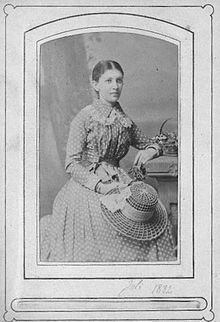Religion Judaism | Name Martha Bernays | |
 | ||
Died November 2, 1951, London, United Kingdom Children Anna Freud, Ernst L. Freud Parents Emmeline Bernays, Berman Bernays Grandchildren Lucian Freud, Clement Freud, Stephan Gabriel Freud Similar People Sigmund Freud, Anna Freud, Amalia Freud, Clement Freud, Lucian Freud | ||
Cartas de Amor (Sigmund Freud)
Martha Bernays (/bərˈneɪz/; [bea̯ˈnaɪs]; 26 July 1861 – 2 November 1951) was the wife of Austrian psychoanalyst Sigmund Freud.
Contents
- Cartas de Amor Sigmund Freud
- Sigmund Freud y Martha Bernays
- Background
- Courtship and marriage
- Character
- Menage a trois
- References
Bernays was the second daughter of Emmeline and Berman Bernays. Her paternal grandfather Isaac Bernays was a Chief Rabbi of Hamburg.
Sigmund Freud y Martha Bernays
Background
Martha Bernays was raised in an observant Orthodox Jewish family. Her grandfather, Isaac Bernays, was the chief rabbi of Hamburg and a distant relative of the German Romantic poet Heinrich Heine and whom Heine frequently mentioned in letters. Isaac's son, Michael Bernays (1834-1897), Martha's uncle, converted to Christianity at an early age and was professor of German at the University of Munich. Although the Bernays and Freud families were well acquainted - her elder brother Eli marrying husband Freud's younger sister, for example - the latter were more liberal Jews, and Freud in particular had no time for ritual observances: Martha told a cousin that "not being allowed to light the Sabbath lights on the first Friday night after her marriage was one of the more upsetting experiences of her life". She was also the aunt of Austrian-born American publicist and "father of public relations", Edward Bernays.
Courtship and marriage
Sigmund and Martha met in April 1882 and after a four-year engagement (1882–1886) they were married on 14 September 1886 in Hamburg.
Freud and Bernays’s love letters sent during the engagement years, according to Freud's official biographer Ernest Jones, who read all the letters, "would be a not unworthy contribution to the great love literature of the world." Freud sent over 900 (lengthy)letters to his fiancee, which chart the ups and downs of a tempestuous relationship, marred by outbreaks of jealousy on his part as well as affirmations that "I love you with a kind of passionate enchantment".
Their eventual marriage was a much more harmonious affair - Martha consoling herself after his death with the thought that "in the 53 years of our marriage there was not a single angry word between us". The couple had six children: Mathilde (born 1887), Jean-Martin (born 1889), Oliver (born 1891), Ernst (born 1892), Sophie (born 1893), and Anna (born 1895).
Character
The young Martha Bernays was a slim and attractive woman who was also a charmer, intelligent, well-educated and fond of reading (as she remained throughout her life). As a married woman, she ran her household efficiently, and was indeed almost obsessive about punctuality and dirt. Firm but loving with her children, she spread an atmosphere of peaceful joie de vivre through the household, (at least according to the French analyst Rene Laforgue). However Martha was not able to establish a strong connection between her youngest daughter, Anna.
Menage a trois?
Bernays’s younger sister, Minna Bernays, was very close to the young couple, and moved in with them in the 1890s, to set up what has (jokingly) been called a menage a trois. Sigmund and Minna would sometimes holiday together; and the suggestion has periodically been made that she in fact became Freud's mistress. Jung for example reported (late in life) that from Minna he "learned that Freud was in love with her and that their relationship was indeed very intimate".
This claim was (and is) controversial. The publication of a hotel log from 1898 registering the pair as "Dr Sigm Freud u frau" in a double room has prompted some Freud scholars, including his defender Peter Gay, to regard the conjecture of Freud and Minna having an affair as possibly accurate; other proponents of the affair however - relying on their analysis of Freud's own autobiographical writings - believe that it was only consummated in 1900.
Opponents point to the unlikelihood of such a betrayal taking place between sisters as close as Minna and Martha, especially given the mores of the time; and to the less sensational possibility of the hotel simply being full at the time. Pending publication of the Freud/Minna correspondence for the period 1893–1910, the truth behind such speculations may not be known for sure.
What does seem certain is that Martha herself in no way knew of, or colluded in, any such affair. Freud himself described her as thoroughly good, where he and Minna were more self-willed and wild; and for better or worse her commitment to conventional morality, domestic duty and family values is clear. (Her husband too had shocked Andre Breton by his lack of any Bohemianism, and considered a sexually promiscuous woman as "simply a Haderlump [a ragamuffin]".) Martha's attitude to infidelity is perhaps best illustrated by her reaction to their friend Stefan Zweig leaving his wife Frederica for a younger woman: six years after Zweig's death in 1942, Martha wrote to his widow that she still resented "our friend's infidelity to you!"
